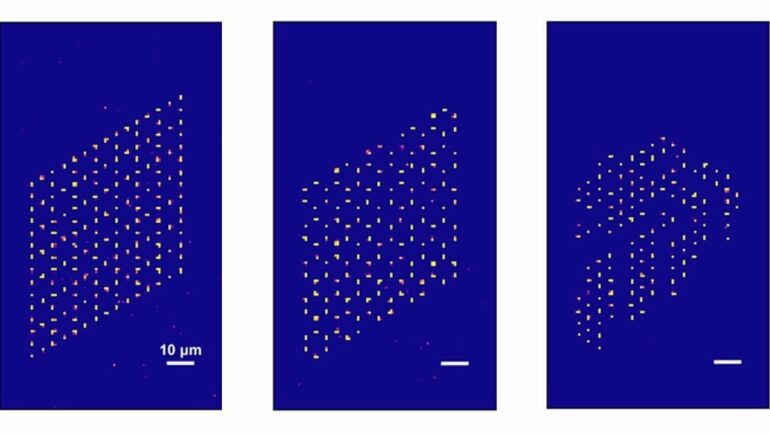The glowing dots in these images are single rubidium atoms, pristinely arranged in arrays about as wide as a human hair. The team of CQT Principal Investigator Loh Huanqian captured these pictures to show how they can assemble atoms into any pattern—even Singapore’s Lion Head symbol—fitting within a 15 by 15 triangular grid. The researchers describe the setup and novel algorithm that makes this possible in a paper published 15 March 2023 in Physical Review Applied.
Researchers are keen to work with arrays of neutral atoms because, like Lego blocks that can be assembled into prototype buildings, atom arrays can be used to perform powerful quantum simulations of materials. Already scientists use supercomputers to calculate material properties, but the calculations quickly become intractable if you try to simulate more particles. With an atom array, scientists can model materials directly.
The CQT group’s approach allowed them to achieve a state-of-the-art defect-free array size of 225 atoms reliably at room temperature. Perfection in the pattern is important because defects, or missing atoms, in an array have been found to deteriorate the observed signal in quantum simulations.
Rearranging atoms in parallel
To assemble their atom arrays, the group starts by trapping atoms using laser beams also known as optical tweezers. Trapping single atoms involves an element of chance, so not every tweezer is successfully loaded with an atom. This means that even though the researchers begin with an array of 400 tweezers, they end up with an atom array full of defects. In the next step, they rearrange the atoms in real time to form a smaller, defect-free target array.
This is where the team’s approach diverges from existing approaches. Previous efforts to rearrange atoms have focused on moving the atoms one at a time using a single extra optical tweezer, after calculating the smallest number of moves needed. Atoms do not stay in their traps forever, so minimizing the number of moves, and so the time needed for the rearrangement, increases the probability of achieving a defect-free array.
Huanqian and her group members have developed a system that instead speeds up the rearrangement by moving many atoms in parallel with multiple tweezers. In their experiment, up to 15 mobile tweezers can be used to move atoms simultaneously to generate the defect-free array. The maximum number of mobile tweezers involved can be specified by the user.
“Moving the atoms one at a time is like playing the piano with one finger,” says Weikun, who is the first author of the paper. “In our protocol, we use more fingers and can play the piano faster, which saves a lot of time. For example, if we had 100 atoms to move, instead of making 100 moves one at a time, we could move ten atoms at a time. This means that the number of moves we make is ten times smaller.”
To make this work, the researchers designed a novel algorithm that calculates what moves to make.
Strategic moves
The algorithm’s input comes from an image of how the atoms are initially loaded. The image is converted to a binary matrix, with values 1 and 0 representing if an atom is successfully trapped in the tweezers or not. The researchers also specify the target array.
The rearrangement strategy consists of two parts. The first is row sorting. In this procedure, atoms in the rows are redistributed among the columns such that each column has the number of atoms required in the target array. The second is a column compression procedure that moves the atoms to their target positions.
To ensure atoms do not collide during moves, which could knock them out of the array, the group specified that the algorithm should always move atoms with the same speed and preserve their order.
After completing the calculation, the algorithm communicates with the hardware. Optical tweezers, acting as mechanical arms, rearrange the atoms row by row, then column by column. The group call their algorithm the parallel sort-and-compression algorithm, which can complete the array assembly faster than a blink of an eye.
“Coding is one of the most difficult parts of the experiment,” says Weikun. “Our algorithm sees the whole picture, designs the entire move set in one go, makes sure that there is no collision and then conducts it.”
With their novel algorithm, the group experimentally realized the defect-free 225-atom array with a success probability of 33%, which is among the highest success probabilities reported in the literature for room temperature setups. The team expects their success probability can be improved with quieter and more powerful laser sources.
“We have demonstrated that we can apply our algorithm to arbitrary geometries such as the honeycomb, kagome, and link-kagome, which are interesting for studying different advanced materials like graphene, superconductors or quantum spin liquids,” says Huanqian. “Just to show that we’ve done this in Singapore, we also rearranged the single atoms to form the Lion Head symbol.” The Lion Head symbol was introduced as a national symbol in 1986 and symbolizes courage, strength and excellence.
More information:
Weikun Tian et al, Parallel Assembly of Arbitrary Defect-Free Atom Arrays with a Multitweezer Algorithm, Physical Review Applied (2023). DOI: 10.1103/PhysRevApplied.19.034048
Provided by
National University of Singapore
Citation:
Quantum scientists achieve state-of-the-art defect-free atom array (2023, April 26)



